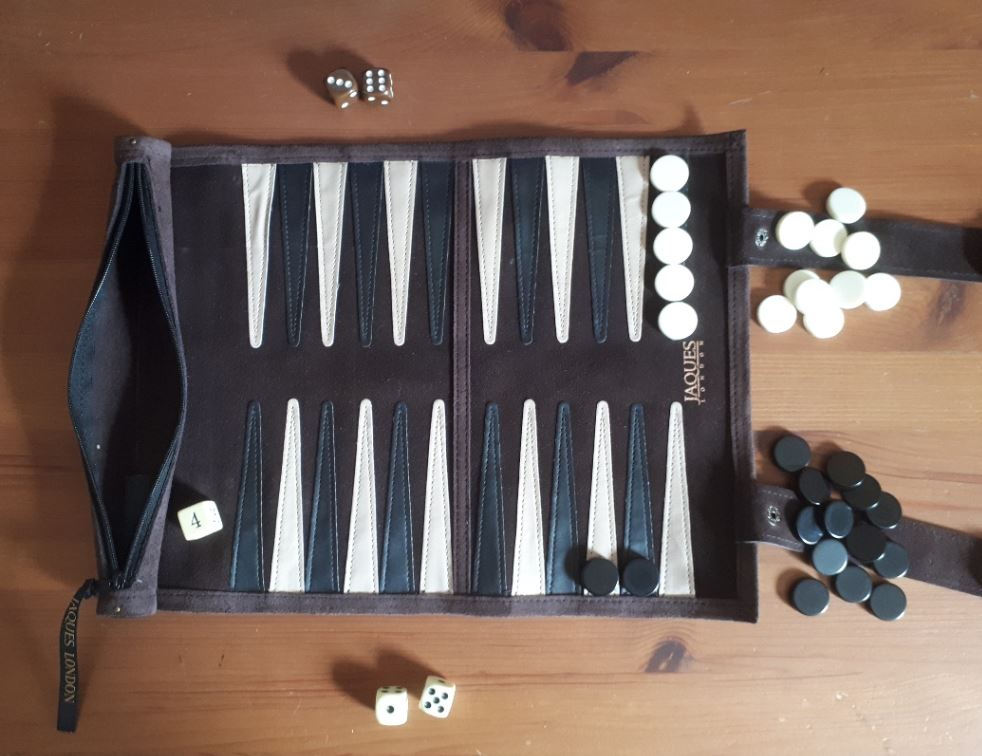Last updated on October 29, 2022
This is another post in our Deluxe Backgammon series for beginners. The concept of wastage in backgammon refers to the number of pips that are left unused in the bear-off stage of the game. For example, using a dice roll of 6 to bear a checker off from the 3-point would result in the wastage of 3 pips. It is particularly important to avoid wastage when both players are simultaneously bearing-off. Too much wastage is one of the main reasons why players with lesser pip counts at the end game lose the bear-off race.
Example
For example, imagine that white has five checkers left on their 1-point and black has one checker each on their 3-point and 2-point. The pip count for both is five, but one of the players has a clear advantage in the race and this is due to wastage. Even with a double, white, needs at least two rolls to bear-off all of their checkers. Black can bear-off in a single roll, and in fact, has a high probability (69%) of doing so. This is an example of why we should always try to minimise wastage when bearing off to maximise the values of the dice rolls.
Another way of looking at the above example is to take a more realistic look at the pip count. The average number of pips in a roll is 8.167. (The average number of pips in a roll would be 7 if rolling a double didn’t add a double pip count. For example, a double-5 yields 20 pips, not 10). As doubles are considered in this figure, we are going to assume that it will take white three rolls to bear off, 3 x 8.167 = 24.5. If we subtract the pip count of 5, we see that the wastage value is 19.5. In contrast, black has a 69% chance of bearing off in a single roll, 1 x 8.167 = 8.167. If we subtract the pip count of 5, we see that the wastage value is only 3. This gives black a considerable advantage in the race to bear-off.
Minimising wastage
There are two ways on how we can minimise wastage in the backgammon bear-off. First, we should refrain from stacking checkers on lower points when a roll allows us to take them off. Secondly, where possible avoid leaving gaps in your home board. Gaps and over stacked points also lead to wastage in the bear-off phase. That’s why it’s important that, as we’re bearing in checkers, to slot on different points. This allows you to maximise the use of rolls later on. Obviously, this changes if you still have contact with your opponent’s checkers in your home board or on the bar. Those scenarios require specialised tactics.
Contact
If there is contact and you are bearing off, you are likely to be ahead in the race. In this case, avoiding getting hit should take priority over wastage. In general, move pieces off your highest points when it is safe to do so without leaving a blot. As you clear the higher points, a high roll from your opponent can force them to leap over your checkers and break contact. Try to keep an even number of checkers on your highest occupied points. This is to avoid being forced to leave a blot due to a high roll. For example, if your highest occupied point is the 5 and it has three checkers, a roll of 6-5 would force you to bear off two of those checkers. This would leave a single checker on the 5-point, which would be vulnerable to a hit.
If contact is broken
Once contact is broken the tactics change. Try to avoid stacking too many checkers on a single point. Because this can limit your options and lead to wastage. An example of over-stacking wastage is when you have five checkers on each of your 5-point, 3-point and 1-point. If you roll double two, you have no choice but to crunch checkers from the 5 and 3-points to lower points without bearing any checkers off the board. Where possible, try not to leave any gaps between points, because this minimises the potential for wasted pips.
It’s important to minimise wastage in the backgammon bear-off phase. This is because, at the final stage of the race, every roll is critical.


Good explanation. I can now see how wastage can be a problem. Previously I was guilty of stacking checkers on the lower points. This post has definitely improved my backgammon.
Hi Milo, pleased to be able to help. Try reading our post on how to improve your backgammon game for more ideas. Thanks for taking the time to comment, Jason